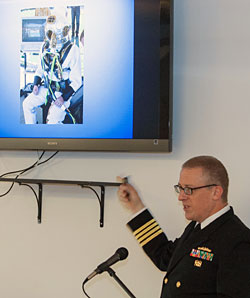U.S. Navy captain, researcher discusses undersea medicine
By: Paul Bello, National Museum of Health and Medicine
SILVER SPRING, Md. – Undersea medicine was the topic during the July Medical Museum Science Café, presented by the National Museum of Health and Medicine (NMHM). The talk, held at the Silver Spring Civic Building and attended by nearly 50 people, was entitled "Undersea Medicine Research: Improving Performance under Pressure" and featured U.S. Navy Capt. David Regis, head of the Undersea Medicine Department, Navy Medical Research Center (NMRC) on the Fort Detrick-Forest Glen Annex.
A medical diving officer, Regis has served as head of Biomedical Research for the Navy at its Experimental Diving Unit in Panama City, Fla., in addition to Chief of Pediatric Infectious Diseases before transitioning to his current position at NMRC. Regis focused his talk on decompression sickness. Along with its sister Navy labs and private sector institutions, he said NMRC has uncovered approaches that can help mitigate decompression sickness.
"Our bodies have evolved to live at a certain depth. So any change from that is a change in our physiology that we're normally supposed to be living at," Regis said. "Oxygen is used to create all our energy systems that keep us alive. But the larger part of air is nitrogen which is an inert gas. That's the one we get worried about with decompression sickness. It's what causes bubbles which are believed to be a major contributor to decompression sickness."
As Regis explained, a diver breathing compressed air takes on more nitrogen underwater because the amount is greater at surface level due to the increased pressure at depth. That extra nitrogen is then taken on by the individual's body tissues.
When a diver surfaces, that nitrogen must come out of one's system. If someone comes up too fast, problems can occur due to bubbles and other physiological side effects. These problems range from the aches and pains of "the Bends" to life threatening neurologic and/or cardiopulmonary signs and symptoms, Regis said.
The Navy has examined ways of treating decompression sickness, which usually occurs 10 minutes to 48 hours after a dive, without a recompression chamber - the current mainstay of treatment - Regis said. Other studies examine the effects of decompression sickness on certain medications originally developed for other purposes.
"We're still trying to figure out all the mechanisms involved with decompression sickness," Regis said. "The theory is that these bubbles initiate something, either an inflammatory cascade or they can just get trapped in tissues."
Studies by the Naval Submarine Medical Research Lab in Groton, CT, have shown that propranolol, a medication generally prescribed for high-blood pressure, can actually help lower an individual's metabolic demands in an atmosphere like a disabled submarine, Regis said. This is important because it extends the crew viability for another day or two while awaiting rescue. However, Regis points out that it is unknown if this drug will have any effect on decompression sickness when the recovered personnel are then exposed to a change in pressure.
NMHM's Medical Museum Science Cafés are a regular series of informal talks that connect the mission of the Department of Defense museum with the public. NMHM was founded as the Army Medical Museum in 1862 and moved to its new location in Silver Spring, Md. in 2012. The next Science Café is entitled "Bacteriophage Therapy: Is There an Alternative to Antibiotics?" It will be held Tuesday, Aug. 26 from 6-7 p.m. at the Silver Spring Civic Building. The program is free and open to the public.
 |
Caption: U.S. Navy Capt. David Regis, head of the Undersea Medicine Department, Naval Medical Center Research Center (NMRC), discusses the effects of decompression sickness during the National Museum of Health and Medicine's July Medical Museum Science Café, held July 22 at the Silver Spring Civic Building. |



